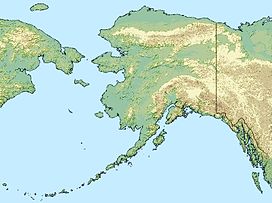- Mount Wrangell
-
Mount Wrangell 
Mount Wrangell, 1987Elevation 14,163 ft (4,317 m) [1] Prominence 5,563 ft (1,696 m) [citation needed] Listing Ultra Location Wrangell-St. Elias National Park and Preserve, Alaska, USA Range Wrangell Mountains Coordinates 62°00′21″N 144°01′10″W / 62.00572°N 144.01935°WCoordinates: 62°00′21″N 144°01′10″W / 62.00572°N 144.01935°W[1] Topo map USGS Gulkana A-1 Geology Type Shield volcano Age of rock Pleistocene Volcanic arc/belt Wrangell Volcanic Field Last eruption 2002[2] Mount Wrangell is a massive shield volcano located in Wrangell-St. Elias National Park and Preserve in southeastern Alaska, United States. The shield rises over 12,000 feet (3,700 m) above the Copper River to its southwest. Its volume is over 220 cubic miles (920 km3), making it more than twice as massive as Mount Shasta in California, the largest stratovolcano by volume in the Cascades. It is part of the Wrangell volcanic field, which extends for more than 250 km across Southcentral Alaska into the Yukon Territory, and has an eruptive history spanning the time from Pleistocene to Holocene.
Modern Mount Wrangell, built upon the remnants of a mid-Pleistocene volcano, has an eruptive history spanning from 750,000 years ago to minor phreatic eruptions in 1884.[3] An ice-filled caldera 2.5 by 3.7 miles (4 by 6 km) in diameter lies at the top of Wrangell's broad shield. The caldera was apparently formed by subsidence rather than large explosive eruptions. The caldera is in turn rimmed by three small craters, which often display fumarolic activity with steam plumes that can sometimes be seen from a distance. The main summit is on the north side of the caldera, while the west summit rises to 14,013 feet (4,271 m). The summit region above 13,000 feet (4,000 m) in elevation is over 2 by 5 miles (3 by 8 km) in size. A very large cinder cone, 13,009-foot (3,965 m) Mount Zanetti, rises nearly 1,000 feet (300 m) above the northwest flank of Wrangell and is the source of some lava flows.
Wrangell is unusual in that despite being a shield volcano, it is made mainly of andesite rather than basalt, which forms most shield volcanoes in other parts of the world. A few other volcanoes in the Wrangell Volcanic Field also share this feature. Andesite is a volcanic rock found mainly in stratovolcanoes and tends to form short, stubby flows. How Wrangell grew into a shield volcano is poorly understood, but its lava flows appear to have been voluminous and were also probably generated by high eruption rates.
Wrangell is the only volcano in the Wrangell Volcanic Field to have had historically recorded eruptions, generally in the form of small steam and ash explosions. The amount of geothermal heat being emitted by Wrangell has been increasing since the 1950s, raising the possibility of a future eruption. Also, the heat flux has been high enough to melt ice around the craters and create ice caves.
See also
- 4000 meter peaks of Alaska
- 4000 metre peaks of Canada
- 4000 meter peaks of North America
- 4000 meter peaks of the United States
- Mountain peaks of Alaska
- Mountain peaks of Canada
- Mountain peaks of North America
- Mountain peaks of the United States
- Level Mountain Range (largest shield volcano in British Columbia)
References
- ^ a b "Wrangell description and statistics". Alaska Volcano Observatory. http://www.avo.alaska.edu/volcanoes/volcinfo.php?volcname=Wrangell. Retrieved 2009-01-06.
- ^ "Wrangell". Global Volcanism Program, Smithsonian Institution. http://www.volcano.si.edu/world/volcano.cfm?vnum=1105-02-. Retrieved 2009-01-06.
- ^ Volcanoes of North America, Wood and Kienle
- Richter, Donald H.; Danny S. Rosenkrans and Margaret J. Steigerwald (1995). Guide to the Volcanoes of the Western Wrangell Mountains, Alaska. USGS Bulletin 2072. http://www.nps.gov/wrst/naturescience/guide-to-the-wrangell-volcanoes.htm.
- Winkler, Gary R. (2000). A Geologic Guide to Wrangell—Saint Elias National Park and Preserve, Alaska: A Tectonic Collage of Northbound Terranes. USGS Professional Paper 1616. ISBN 0-607-92676-7. http://pubs.usgs.gov/pp/p1616/.
- Richter, Donald H.; Cindi C. Preller, Keith A. Labay, and Nora B. Shew (2006). Geologic Map of the Wrangell-Saint Elias National Park and Preserve, Alaska. USGS Scientific Investigations Map 2877. http://pubs.usgs.gov/sim/2006/2877/.
- Wood, Charles A.; Jürgen Kienle, eds. (1990). Volcanoes of North America. Cambridge University Press. ISBN 0-521-43811-X.
Categories:- Landforms of Valdez–Cordova Census Area, Alaska
- Shield volcanoes
- Active volcanoes
- Pleistocene volcanoes
- Mountains of Alaska
- Volcanoes of Alaska
- Wrangell–St. Elias National Park and Preserve
Wikimedia Foundation. 2010.


